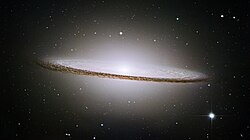Fichiér:Sombrero Galaxy in infrared light (Hubble Space Telescope and Spitzer Space Telescope).jpg

Talye de cél apèrçu : 800 × 448 pixèls. Ôtres rèsolucions : 320 × 179 pixèls | 640 × 359 pixèls | 1 024 × 574 pixèls | 1 280 × 717 pixèls | 3 000 × 1 681 pixèls.
Fichiér d’origina (3 000 × 1 681 pixèls, talye du fichiér : 3,98 Mio, tipo MIME : image/jpeg)
Historico du fichiér
Cllicar dessus na dâta et hora por vêre lo fichiér coment il ére a cél moment.
| Dâta et hora | Miniatura | Dimensions | Utilisator | Comentèro | |
|---|---|---|---|---|---|
| d’ora | 20 julyèt 2009 a 20:46 |  | 3 000 × 1 681 (3,98 Mio) | Tryphon | {{Information |Description=NASA/ESA Hubble Space Telescope and NASA's Spitzer Space Telescope joined forces to create this striking composite image of one of the most popular sights in the universe. Messier 104 is commonly known as the Sombrero galaxy bec |
Usâjo du fichiér
Cetes 2 pâges emplèyont cél fichiér :
Usâjo gllobâl du fichiér
Cetos ôtros vouiquis emplèyont cél fichiér :
- Usâjo dessus ast.wikipedia.org
- Usâjo dessus az.wikipedia.org
- Usâjo dessus bs.wikipedia.org
- Usâjo dessus cs.wikipedia.org
- Usâjo dessus de.wikipedia.org
- Usâjo dessus en.wikipedia.org
- Usâjo dessus en.wikiquote.org
- Usâjo dessus en.wikiversity.org
- Usâjo dessus es.wikipedia.org
- Usâjo dessus fa.wikipedia.org
- Usâjo dessus fr.wikipedia.org
- Usâjo dessus he.wikipedia.org
- Usâjo dessus id.wikipedia.org
- Usâjo dessus it.wikibooks.org
- Usâjo dessus kk.wikipedia.org
- Usâjo dessus kn.wikipedia.org
- Usâjo dessus mg.wikipedia.org
- Usâjo dessus pl.wikipedia.org
- Usâjo dessus pt.wikipedia.org
- Usâjo dessus simple.wikipedia.org
- Usâjo dessus sk.wikipedia.org
- Usâjo dessus sv.wikipedia.org
Vêre més d’usâjo gllobâl de cél fichiér.


